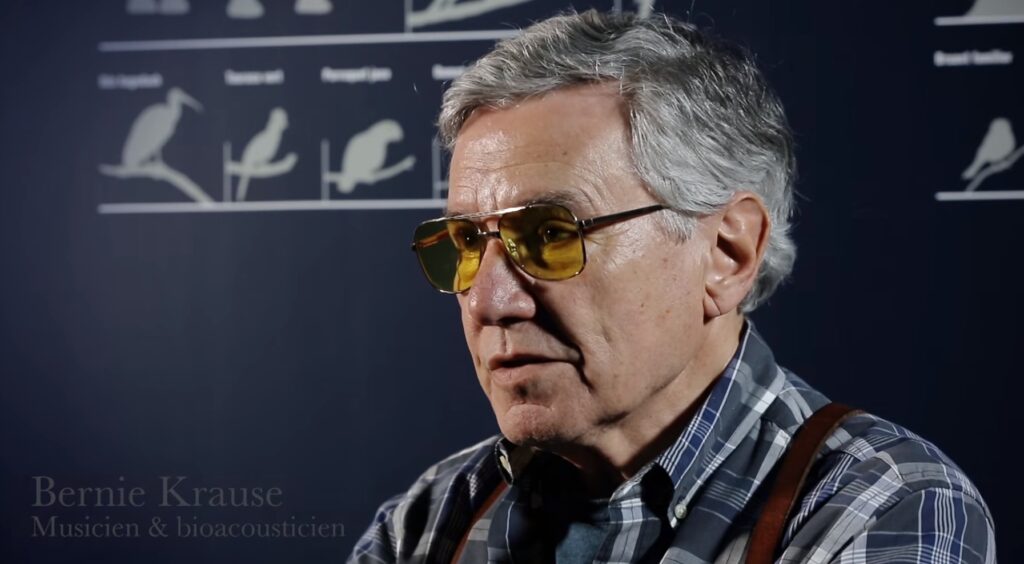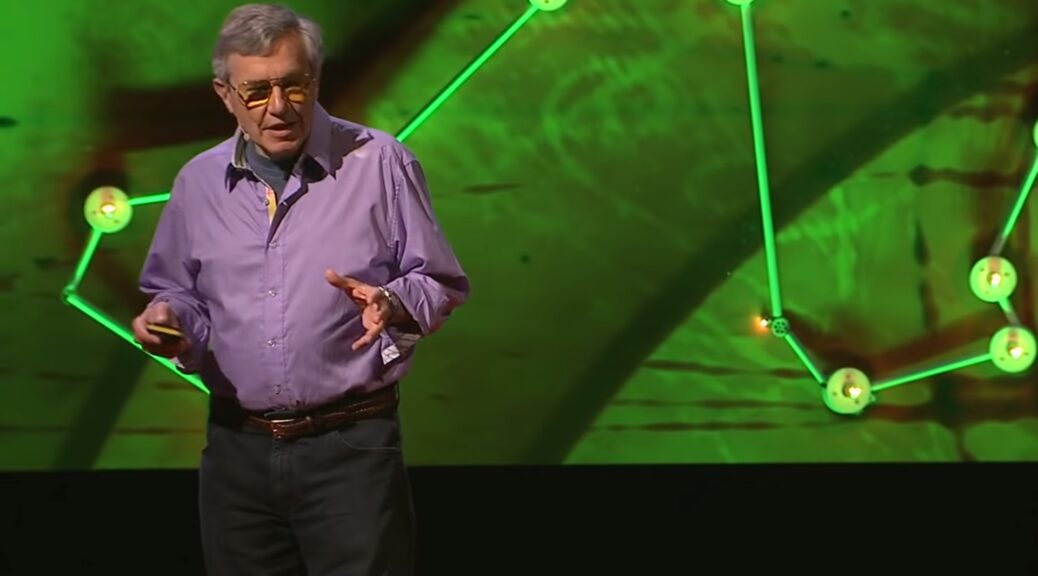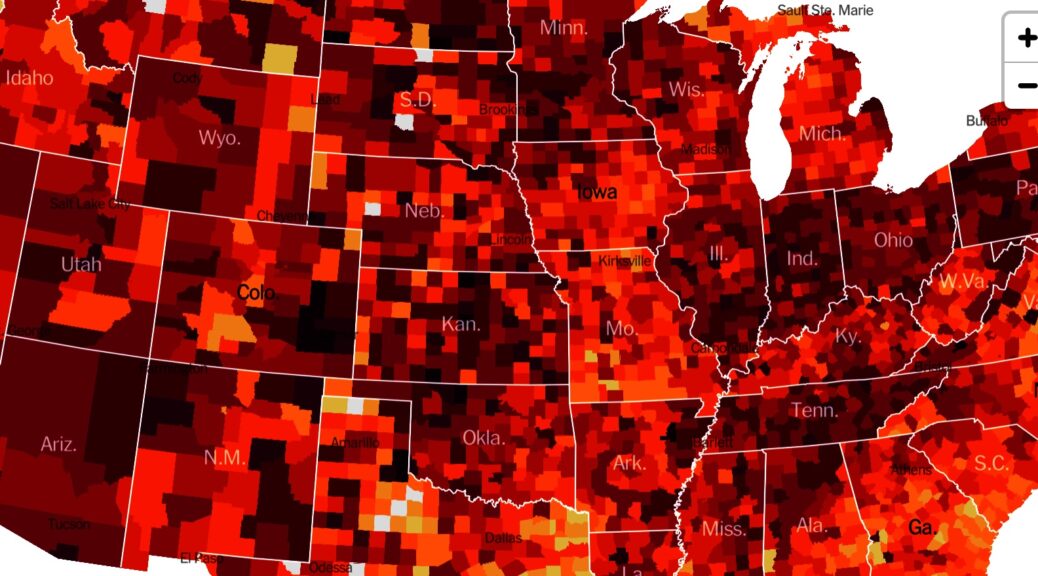In November, voters had legitimately elected Joe Biden to be President. Without any actual evidence, President Trump continuously and baselessly claimed voter fraud despite State election officials’ diligent recount evidence to the contrary and judges’s tossing the dozens of President Trump’s lawyers challenges.
President Trump’s obsessive fixation on his defeat exacerbated his continued lackluster response to the worsening COVID-19 pandemic catastrophe.
The virus and the illness that it causes, COVID-19, was first identified in Wuhan, China, in December 2019, but it wasn’t until January 19 that the first confirmed COVID-19 case, from a traveler returning from China, was found in the U.S.
December 1: 63,750,408 cases worldwide; 1,477,230 deaths worldwide
274,386 COVID Deaths USA
December 1: 13,923,758 cases in the USA; 274,386 deaths in the USA.
Advisory Committee Recommendations
December 2: the Advisory Committee on Immunization Practices, an independent panel advising the Centers for Disease Control and Prevention, voted to recommend that residents and employees of nursing homes and similar facilities be the first people in the United States to receive coronavirus vaccines, along with health care workers who are especially at risk of being exposed to the virus.
The panel voted 13 to 1 during an emergency meeting to make the recommendation. The director of the C.D.C., Dr. Robert R. Redfield, was expected to decidequickly whether to accept it as the agency’s formal guidance to states as they prepared to start giving people the shots as soon as within two weeks.
“We are acting none too soon,” said Dr. Beth Bell, a panel member and global health expert at the University of Washington, noting that Covid-19 would kill about 120 Americans during the meeting alone. [NYT article]
December 2020 COVID 19
The UK First
December 3: the NYT reported that Britain gave emergency authorization to Pfizer’s coronavirus vaccine, leaping ahead of the United States to become the first Western country to allow mass inoculations against a disease that had killed more than 1.4 million people worldwide.
US Single-Day Record
December 3: the United States recorded its single-worst daily death toll since the pandemic began, and on a day when Covid-19 hospitalizations also hit an all-time high, the pace of loss showed no signs of slowing any time soon.
Not since spring, during the pandemic’s first peak, were so many deaths reported. The high point then was 2,752 deaths on April 15. On this date, it was at least 2,760.
Hospitalizations from the virus topped 100,000 — more than double the number at the beginning of November. That was a clear indicator of what the days ahead may look like, experts say.
“If you tell me the hospitalizations are up this week, I’ll tell you that several weeks down the road, the deaths will be up,” said Dr. Jeremy Faust, an emergency medicine physician at Brigham and Women’s Hospital in Boston. [NYT article]
December 2020 COVID 19
December 4: the United States finished one of the very worst weeks since the coronavirus pandemic had began nine months ago.
On December 4, a national single-day record was set, with more than 226,000 new cases. It was one of many data points that illustrated the depth and spread of a virus that had killed more than 278,000 people in this country, more than the entire population of Lubbock, Texas, or Modesto, Calif., or Jersey City, N.J.
“It’s just an astonishing number,” said Caitlin Rivers, a senior scholar at the Johns Hopkins Center for Health Security. “We’re in the middle of this really severe wave and I think as we go through the day to day of this pandemic, it can be easy to lose sight of how massive and deep the tragedy is.” [NYT story]
December 2020 COVID 19
1,527,144 COVID Deaths Worldwide
December 5: 66,358,071 cases worldwide; 1,527,144 deaths worldwide
285,668 COVID Deaths USA
December 5: 14,775,308 cases in the USA; 285,668 deaths in the USA.
December 2020 COVID 19
December 8: Britain’s National Health Service delivered its first shots of the Pfizer-BioNTech Covid-19 vaccine, opening a mass vaccination campaign with little precedent in modern medicine and making Britons the first people in the world to receive a clinically authorized, fully tested vaccine. [NYT story}
December 2020 COVID 19
1,553,081 COVID Deaths Worldwide
December 8: 68,047,740 cases worldwide; 1,553,081 deaths worldwide
290,474 COVID Deaths USA
December 8: 15,370,339 cases in the USA; 290,474 deaths in the USA.
December 2020 COVID 19
December 9: the NYT reported that federal data showed more than a third of Americans lived in areas where hospitals were running critically short of intensive care beds
Hospitals serving more than 100 million Americans reported having fewer than 15 percent of intensive care beds still available as of last previous week, according to a Times analysis of data reported by hospitals and released by the Department of Health and Human Services.
Many areas were even worse off: one in 10 Americans — across a large swath of the Midwest, South and Southwest — lived in an area where intensive care beds are either completely full, or fewer than 5 percent of beds are available. At these levels, experts say maintaining existing standards of care for the sickest patients may be difficult or impossible.
“There’s only so much our frontline care can offer, particularly when you get to these really rural counties which are being hit hard by the pandemic right now,” said Beth Blauer, director of the Centers for Civic Impact at Johns Hopkins University.
December 2020 COVID 19
December 11: the Food and Drug Administration authorized Pfizer’s Covid-19 vaccine for emergency use, clearing the way for millions of highly vulnerable people to begin receiving the vaccine within days.
The authorization was an historic turning point in a pandemic that had already taken more than 290,000 lives in the United States. With the decision, the United States became the sixth country — in addition to Britain, Bahrain, Canada, Saudi Arabia and Mexico — to clear the vaccine. Other authorizations, including by the European Union, were expected within weeks. [NYT article]
December 2020 COVID 19
1,607,590 COVID Deaths Worldwide
December 12: 71,797,890 cases worldwide; 1,607,590 deaths worldwide
303,600 COVID Deaths USA
December 12: 16,359,904 cases in the USA; 303,600 deaths in the USA.
December 2020 COVID 19
December 14: the first shots were given in the American mass vaccination campaign against the coronavirus pandemic, which had killed more people in the United States — over 300,000 — than in any other country and had taken a particularly devastating toll on people of color. [NYT story]
1,627,068 COVID Deaths Worldwide
December 14: 73,149,501 cases worldwide; 1,627,068 deaths worldwide
307,874 COVID Deaths USA
December 14: 16,915,194 cases in the USA; 307,874 deaths in the USA.
December 2020 COVID 19
December 15: NPR reported that the U.S. Food and Drug Administration authorized the first coronavirus test that people will be able to buy at a local store without a prescription and use for immediate results at home to find out if they’re positive or negative.
The test would cost about $30 and be available by January, according to the Australian company that makes it, Ellume.
December 2020 COVID 19
Employers/Vaccinations
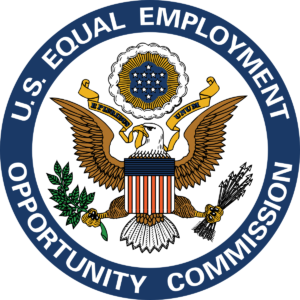
December 16: the U.S. Equal Employment Opportunity Commission [EEOC] issued guidelines regarding COVID vaccinations and employers. The guidance said that employers can require workers to get a Covid-19 vaccine and bar them from the workplace if they refuse/ [NYT article]
Moderna Vaccine
December 18: the Food and Drug Administration authorized the coronavirus vaccine made by Moderna for emergency use, allowing the shipment of millions more doses across the nation and intensifying the debate over who will be next in line to get inoculated. [NYT article]
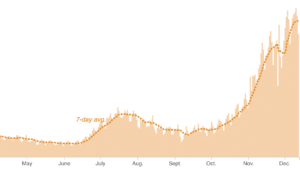
1,683,882 COVID Deaths Worldwide
December 19: 76,131,763 cases worldwide; 1,683,882 deaths worldwide
320,845 COVID Deaths USA
December 19: 17,888,353 cases in the USA; 320,845 deaths in the USA.
December 2020 COVID 19
COVID variant
December 21: the NYT reported that, Britain, struggling to contain an outbreak of what officials said was a more contagious variant of the coronavirus, found itself increasingly isolated as nations raced to ban travelers from the country, suspending flights and cutting off trade routes.
France imposed a 48-hour suspension of freight transit across the English Channel, leaving thousands of truck drivers stranded in their vehicles as the roads leading to England’s ports were turned into parking lots.
1,748,571 COVID Deaths Worldwide
December 24: 79,722,398 cases worldwide; 1,748,571 deaths worldwide
337,066 COVID Deaths USA
December 24: 19,111,326 cases in the USA; 337,066 deaths in the USA.
December 2020 COVID 19
Variant Precautions
December 24: as a new highly transmissible variant of the virus appeared first in Britain, the Centers for Disease Control and Prevention said that the United States would require all airline passengers arriving from Britain to test negative for the coronavirus within 72 hours of their departure.
The rule would apply to Americans as well as foreign citizens, and would require passengers to show proof of a negative result on a genetic test, known as a P.C.R., or an antigen test.
1,764,393 COVID Deaths Worldwide
December 26: 80,709,594 cases worldwide; 1,764,393 deaths worldwide
339,921 COVID Deaths USA
December 26: 19,433,847 cases in the USA; 339,921 deaths in the USA.
December 2020 COVID 19
EU Rollout
December 27: the NY Times reported that the European Union began a COVID vaccination campaign to inoculate more than 450 million people across the EU.
Variant
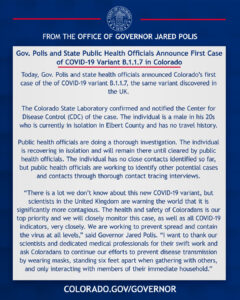
December 28: Colorado, state officials said that a case of the new coronavirus variant, initially seen in the United Kingdom, was found marking the first time the variant had been officially documented in the United States.
Colorado Gov. Jared Polis said that the man who tested positive was in his 20s, had not been traveling and was currently isolating.
“The individual has no close contacts identified so far, but public health officials are working to identify other potential cases and contacts through thorough contact tracing interviews,” the statement said. [NPR story]
1,799,946 COVID Deaths Worldwide
December 29: 82,464,719 cases worldwide; 1,799,946 deaths worldwide
346,579 COVID Deaths USA
December 29: 19,977,704 cases in the USA; 346,579 deaths in the USA.
December 2020 COVID 19
UK/AstraZeneca
December 30: health officials in the U.K. authorized the AstraZeneca-Oxford University COVID-19 vaccine giving the nation a second option for inoculation against the coronavirus.
The government said it would begin rolling out the inexpensive and easy-to-store vaccine beginning January 4, 2021. It ordered 100 million doses — enough to vaccinate 50 million residents, or three-quarters of the country’s population.
The government had already given first doses of the Pfizer-BioNTech vaccine to more than 600,000 Britons. [NPR article]
December 2020 COVID 19
